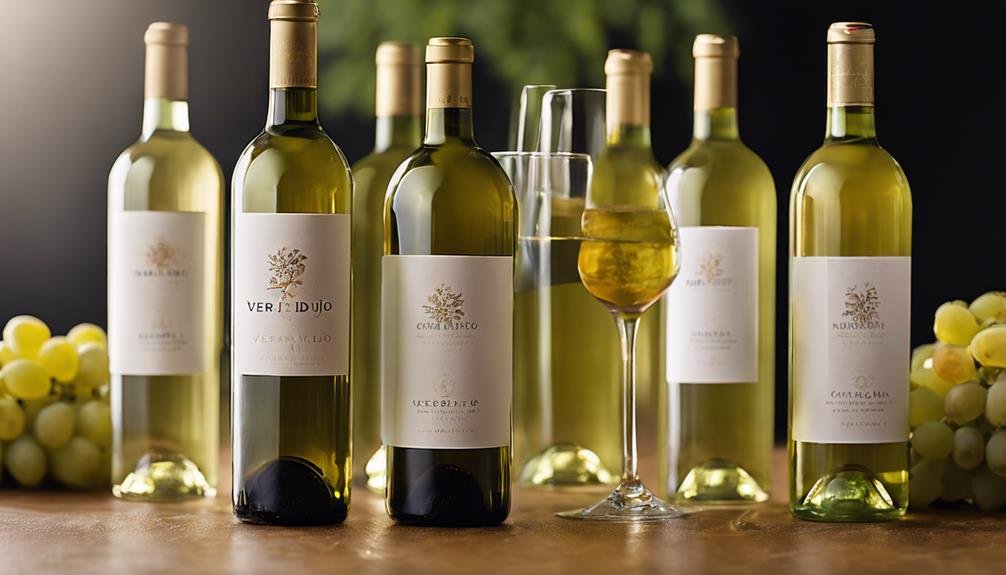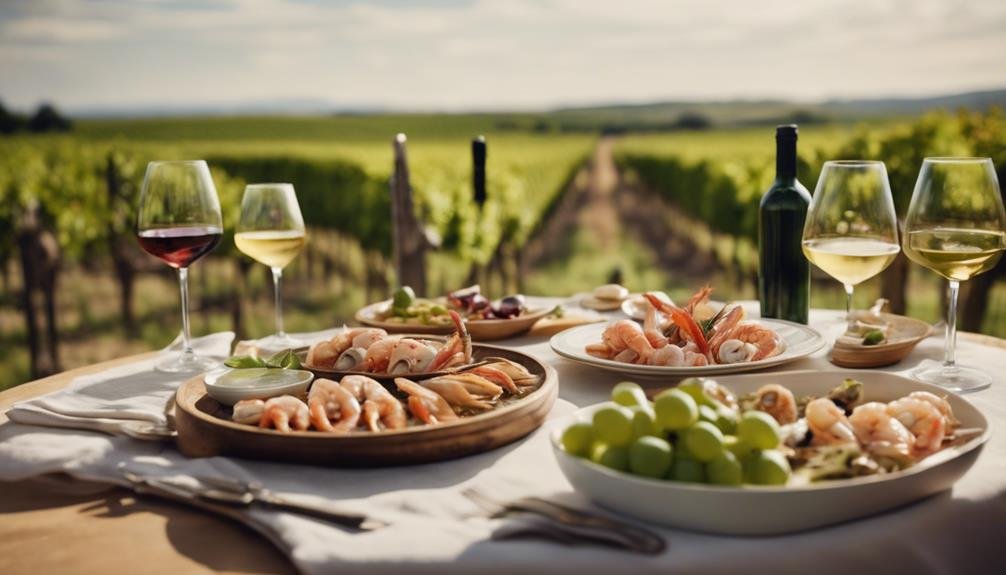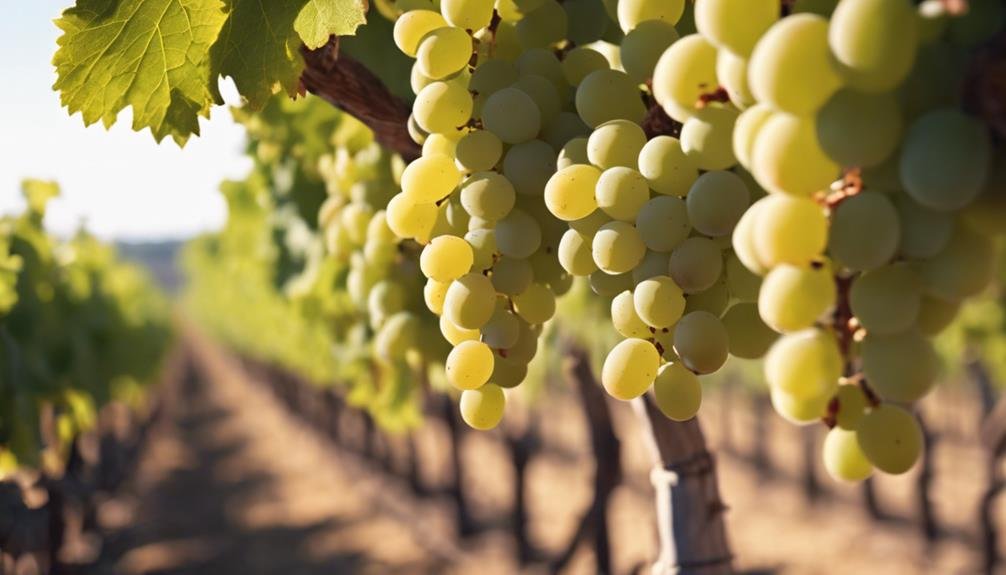Embark on a journey through Verdejo wines, where vibrant citrus notes blend with herbaceous undertones and subtle fennel hints, creating a delightful experience. These wines introduce lime chicken, fish tacos, and dishes with coconut-based sauces, best served chilled at 45-50°F for full revitalizing qualities. Varying aging potentials reveal nuanced flavors, influenced by terroir and oak aging. Rueda, Spain, a key producer, prioritizes vineyard sustainability and employs unique winemaking techniques, resulting in versatile and complex styles. Sample perfect pairings with seafood, Mediterranean, Asian fusion, and vegetarian dishes, showcasing Verdejo's vibrant acidity and citrus notes. Explore the extensive world of Verdejo wines for a flavorful adventure.
Flavor Profile of Verdejo Wines
Verdejo wines exhibit a vibrant flavor profile characterized by a harmonious blend of citrus notes, herbaceous undertones, and a subtle hint of fennel, making them a distinctive choice for wine enthusiasts seeking an invigorating and complex white wine experience.
When considering food pairings, Verdejo complements lime chicken, fish tacos, pork loin, and dishes with coconut-based sauces. Its acidity and bitterness make it an excellent palate cleanser.
To enhance the tasting experience, serve Verdejo chilled at around 45-50°F (7-10°C) to bring out its revitalizing qualities fully. Verdejo also showcases aging potential, evolving in the bottle to develop a rich texture with almond flavors.
Regional variations in Verdejo production, particularly from Rueda in Spain, offer diverse styles catering to different preferences.
Food Pairing Tips for Verdejo
Enhancing the enjoyment of Verdejo wines involves thoughtful consideration of food pairings that complement its vibrant flavors and acidity. The citrus infusion in Verdejo makes it a versatile wine that pairs well with a variety of dishes.
For an invigorating combination, consider pairing Verdejo with lime-infused chicken, fish tacos, or pork loin. The acidity of the wine can also complement fusion cuisine, especially dishes with coconut-based sauces.
Oak-aged Verdejo, with its creamier texture, pairs nicely with richer dishes. To enhance flavors, use Verdejo in recipes where lime is a key ingredient.
Experimenting with different food pairings can elevate the tasting experience of Verdejo wines, showcasing their unique characteristics in a delightful culinary journey.
Exploring Different Styles of Verdejo

Exploring the various styles of Verdejo wines reveals a spectrum of flavor profiles that cater to diverse preferences and palates. When delving into Verdejo, there are several key aspects worth examining:
- Aging Potential: Verdejo wines can showcase varying aging potential, with some styles benefiting from bottle aging to develop richer textures and nuanced flavors.
- Terroir Influence: The terroir where Verdejo grapes are grown plays a significant role in shaping the wine's characteristics, from minerality to fruit expression.
- Oak Influence: Different styles of Verdejo may undergo oak aging, imparting smoky notes and adding complexity to the wine.
- Texture and Mouthfeel: Verdejo wines can range from lean and crisp to creamy and rich, offering a diverse range of textures to explore.
Spotlight on Verdejo From Rueda
With the prominence of Rueda in Spain as a key region for Verdejo production, the spotlight on Verdejo from this area shines brightly, showcasing its exceptional quality and diverse styles.
Vineyard sustainability is a cornerstone of Verdejo production in Rueda, where winemakers prioritize eco-friendly practices to preserve the land for future generations. Unique winemaking techniques, such as early morning harvesting to retain freshness and innovative aging methods, contribute to the essential character of Verdejo wines from Rueda.
Sandy soils in this region, along with century-old vines, play a vital role in crafting expressive and high-quality Verdejo wines that capture the essence of the terroir. Rueda stands out as a hub for Verdejo enthusiasts seeking an array of styles that highlight the grape's versatility and complexity.
Perfect Pairings With Verdejo: Examples

For an exquisite culinary experience, consider pairing Verdejo wines with a selection of diverse dishes that complement its vibrant acidity and citrus notes. When exploring perfect pairings with Verdejo, consider the following examples:
- Seafood Delights: Opt for fresh seafood dishes like grilled shrimp, ceviche, or seafood paella to enhance the citrusy notes of Verdejo.
- Mediterranean Flavors: Embrace the Mediterranean cuisine with dishes like Greek salad, hummus, or grilled octopus, accentuating the wine's invigorating qualities.
- Asian Fusion: Explore Asian fusion cuisine by pairing Verdejo with sushi rolls, Thai green curry, or Vietnamese spring rolls for a delightful culinary adventure.
- Vegetarian Options: For a plant-based pairing, try dishes like grilled vegetable skewers, quinoa salad, or avocado toast to complement Verdejo's lively acidity and herbal undertones.
These pairings will elevate your dining experience and showcase the versatility of Verdejo wines from different wine regions.
Frequently Asked Questions
Can Verdejo Wines Be Aged for Several Years?
Verdejo wines can be aged for several years, showcasing aging potential and flavor development. With bottle aging, Verdejo evolves, gaining a rich texture and nuanced almond notes. Acidity and grassy flavors enhance the wine's complexity.
What Makes Rueda Ideal for Growing Verdejo?
Rueda's terroir, marked by sandy soils and phylloxera-resistant vines, fosters sustainability for growing Verdejo. The region's ideal conditions enhance Verdejo's varietal characteristics, emphasizing expressive flavors, acidity, and longevity, making Rueda a prime location for high-quality Verdejo production.
Are There Any Sparkling Verdejo Wines Available?
Sparkling Verdejo wines offer a invigorating twist on the traditional varietal. These effervescent options bring lively acidity and citrus notes, making them ideal for pairing with seafood, light salads, and appetizers. Enjoy the bubbly Verdejo alongside oysters, ceviche, or fresh green salads.
How Does the Winemaking Process Impact Verdejo Flavors?
Winemaking techniques such as fermentation temperature and aging vessels have a considerable impact on Verdejo flavors. Cold fermentation preserves its citrusy notes, while oak aging adds complexity like almond and smoky nuances. Each method contributes uniquely, crafting a diverse spectrum of flavor profiles in Verdejo wines.
Can Verdejo Wines Be Used in Cooking?
Verdejo wines can enhance culinary creations with their acidity and citrus notes. Use them in marinades for chicken or fish, ceviche, or creamy pasta sauces. The wine's lime and herbal flavors complement various dishes, adding depth and complexity to recipes.
Conclusion
To sum up, Verdejo wines offer a unique and delightful experience for wine enthusiasts, with their vibrant flavors and invigorating acidity.
The comparison to Sauvignon Blanc highlights the distinctiveness of Verdejo, while its ability to evolve gracefully through aging adds depth to its character.
Whether exploring different styles or pairing with a variety of dishes, Verdejo from Rueda, Spain, stands out as a versatile and high-quality option for wine lovers seeking something special.
